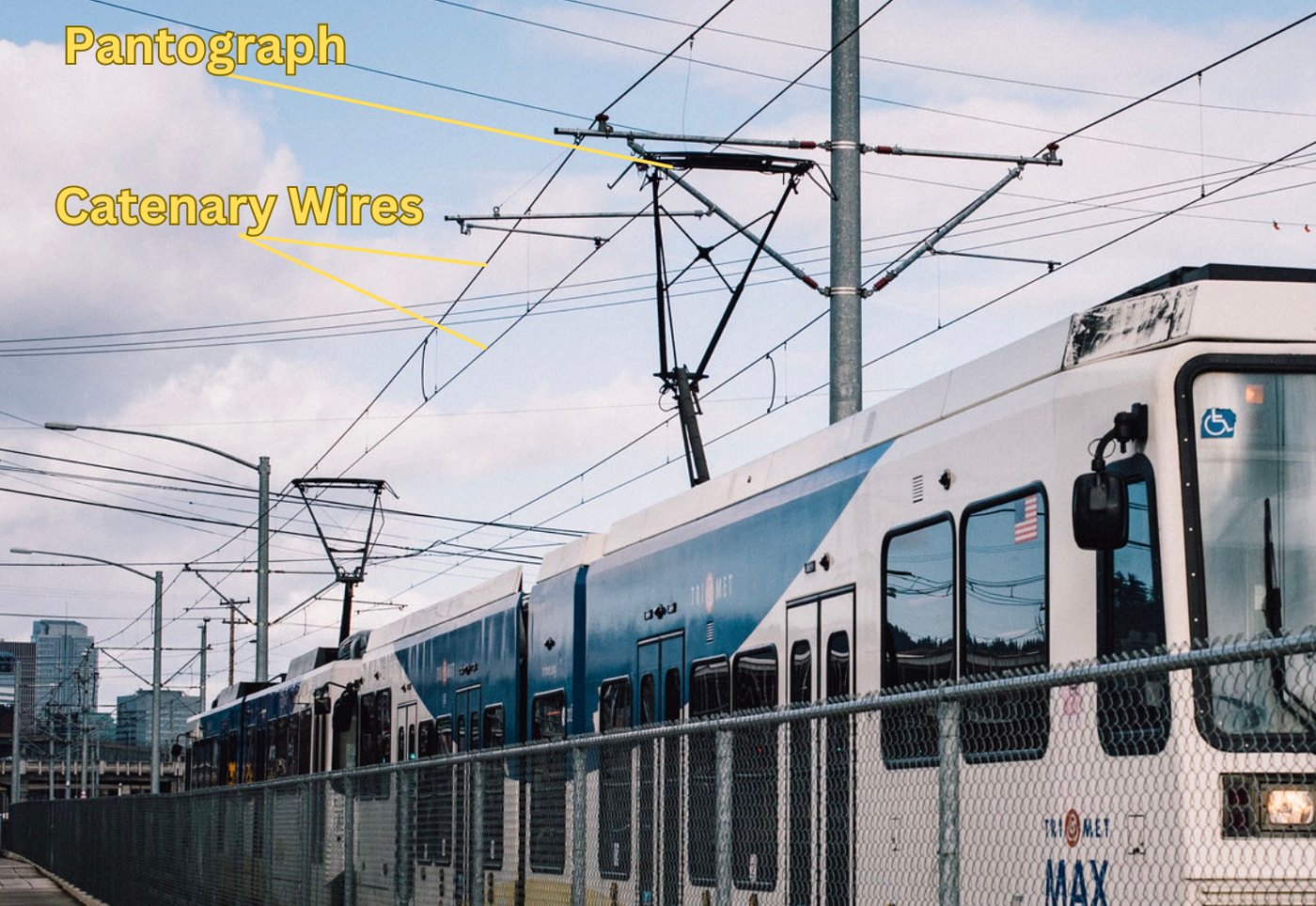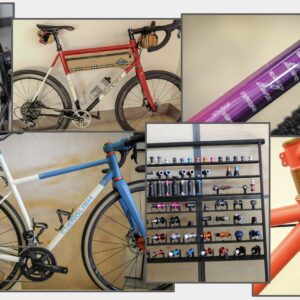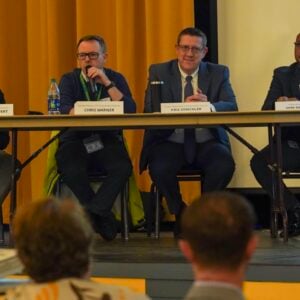
It’s a cruel irony that you can get a free ride to a cooling center on TriMet’s MAX light rail, but you might suffer heat exhaustion waiting for the train to get there.
If there’s one truism when it comes to Portland transportation, it’s that when temperatures go up, the speed of light rail goes down. That’s not ideal, because not only do many folks rely on the MAX system, it’s another way public transit fails in the mode choice competition with cars.
Today is hopefully the last day of extreme heat, at least until the next wave hits us. And as per tradition, TriMet has told MAX riders to expect delays of up to 15-30 minutes due to the heat. Why does this keep happening?
It has to do with the overhead wires that provide electricity to power the trains. Known as catenary wires, these wires must maintain tension in order for train operators to travel at normal speeds. When overheated, the contact wire expands and starts to sag. If an operator goes too fast, the catenary wire could lose contact with the train’s pantograph (a tensioned arm on the roof of the train that connects to the wire) and stall out completely. The slower train speeds and/or temporary stoppages have a ripple effect across the entire system, and delays are inevitable.
Also inevitable are angry customers who just want to get out of the heat. A few days ago after a Timbers game, riders experienced delays of more than 30 minutes. Stories like this lead to frustration and further erode the public’s confidence in public transit at a time when the system desperately needs to win back riders.
Put another way, when catenary wires lose tension, Portlanders gain it.
To counter the increasingly common phenomenon of extreme heat and its impact to their light rail network, TriMet uses a system of weights attached to the poles that hold catenary wires (see video above). As temperature rises, the weights (which weigh about one ton) sag to tension the wires. The weights can rise or fall as much as one inch per degree of temperature change. Sometimes it’s so hot the weights come to rest on the ground and TriMet has no choice but to tell operators to slow way down in order to maintain consistent connection between the pantograph arm and the wire.
With 100 degree-plus temps forecasted today, delays will likely hit the system once again.
So what’s a transit agency to do about the all-powerful sun whose heat is becoming an ever larger force in our daily lives? One problem in Portland is that our light rail system wasn’t built with frequent extreme heat events in mind. In a statement issued last month, TriMet said their MAX system, “was originally designed to operate in the climate Portland enjoyed in the 20th century.” And despite investments they’ve made for heat resiliency since 2018, temperatures above 100 degrees can still cripple their system.
Mitch Green is an energy economist and candidate for City Council District 4. Before this current heat wave, he shared messages on social media that Portland needs to re-invest in its basic infrastructure to handle extreme weather events, lest we remain, “in a state of precariousness.”
Green replied to TriMet’s latest announcement about MAX delays on X yesterday by saying, “We’ve got a situation where the structures and systems we have today, as a product of past investment, are no longer calibrated to the urgency of the moment. But, we don’t throw up our hands: we invest again.” Green says MAX delays aren’t TriMet’s fault and that settling into finger-pointing and status quo investment levels will never allow us to build the “truly resilient systems” we need.
So next time you’re mad about a MAX delay, after pointing your finger at TriMet, point it at the sun — and then point it at yourself. We’re all in this together and it will take a collective effort to fix these problems.
— Before heading out, check TriMet system alerts here.








Thanks for reading.
BikePortland has served this community with independent community journalism since 2005. We rely on subscriptions from readers like you to survive. Your financial support is vital in keeping this valuable resource alive and well.
Please subscribe today to strengthen and expand our work.
As I understand it, the heat can also affect the shape of the rails, right? I was recently in the SF Bay Area and BART was speed-limited in the above-ground sections because the rails expand and buckle in high heat. Is there a way to engineer around that? Surely there is if Phoenix, AZ has a light rail system.
yes, there is but there are tradeoffs too. The temperature which rails buckle has to do with their “rest” temperature (basically the temperature the rail was when it was installed). This can be anything, though as I understand rails are often heated up when they are installed since buckling tends to be a bigger issue at high temps than “pull aparts” at low temps (here’s a blurb on that).
Presumably, Phoenix sets a higher rest temperature than Portland does for their light rail. But Portland also deals with some colder temps, so not really sure how realistic it is for TriMet to just reinstall sections of track with a higher rest temperature – that might cause issues in the winter. But lots of places have higher temperature ranges than Portland. Maybe worth looking into how Chicago or the Twin Cities handle these issues.
Track with wooden ties buckle in high heat; the wider use of reinforced concrete ties largely fixes that issue, not only on light rail but increasingly on mainline track, and of course on the original French TGV lines. It costs a lot more, and the use of concrete is extraordinarily bad for releasing greenhouse gases and climate change, but it’s probably worth it in the end.
All of the light rail lines except for the original part of the Blue line already used concrete ties. And when Trimet rebuilds a section, they use concrete ties to replace wooden ties.
This isn’t a concrete vs. wooden tie issue, it’s one inherent to continuously welded rail. It expands when it’s hot, and if it expands too much it will buckle. If it can’t buckle, it may snap. I imagine the catenary issue is a bigger deal than buckling rails, but not really certain
Does Phoenix have freezing weather in the winter?
My understanding is that accommodating any one temperature is doable, but there’s only a certain range that can be managed. Our tracks can’t go over 100°, but they can get down to 20° and still work. I wouldn’t necessarily expect Phoenix’s high temperature system to be able to function in the extreme cold.
While true, UTA in Salt Lake City has an even greater annual temperature range than us and operate fine in high temperatures. This isn’t an issue we can’t solve.
Thank you for the catenary wires explanation. I’ve always wondered why the electrified rail system was only north of DC but not in the deep south (aside from the Amtrak-owned BOS-WAS line, there are abandoned electrified lines between Chicago and Cleveland.)
I mean, Indian railways are like 90% electrified. Europe sees huge temperature swings, and most of their systems are electrified.
In the US, the issue is that freight railroads are cheep as hell with their infrastructure.
No that’s not the issue. The issue is the size of the consit. 19k ft plus trains are not uncommon here. You will never see frieght railways electrified here. Country is to expansive and we move to much weight.
I’ve never seen length as a reason for electrification to not be practical, the major issue I always see from the big Class I’s is height (which of course is not an issue in India where they run double stacks on electrified lines!).
Plus cost – it’s less expensive for the major railroads as is. If the feds offered to pay for electrification, I think it would stand a chance of working though. It’s not like an electric locomotive is meaningfully less powerful than a diesel electric one.
There are electrified lines* in both Chicago and Cleveland for the record, and you’ll find catenary wires over trains in basically all climates – from Siberia, to India, to Morocco. Coincidentally, the Northeast Corridor does not have constant tension catenary (since it was built by the Pennsylvania Railroad in the early 20th century and hasn’t been upgraded) so Amtrak often struggles in the summer (along with NJT and SEPTA – MetroNorth and the LIRR both use third rail and so don’t have this issue though third rail has other issues).
*technically, the Cleveland lines are local transit – but the Red Line (~subway) runs directly alongside main line tracks for its entire length. Also, the major downtown station is formerly the main railroad station in Cleveland.
Out in the rural countryside between Chicagoland and Lake Erie are long sections of old electrified lines that are gradually being recycled for wood, copper, etc. These were past intercity electric freight lines for the most part.
The two major electrified railroads in Ohio between Cleveland and Toledo ceased operations in 1938 and 1939, respectively (Cincinnati & Lake Erie, Lake Shore Electric). Given that northern Ohio was home to at least 5 different “steam lines” at this time (New York Central, Nickel Plate, Erie, Baltimore & Ohio, and Pennsylvania) on the East Coast to Chicago trip, those interurban abandonments would have been recycled decades ago.
Climate change sucks! I think that part needs to be shared more and louder, about the system being designed for an environment we no longer have.
I also agree with Green’s comments. If we want things to work for people, we don’t point fingers, we don’t throw up our hands: we invest again!
The climate is changing, and our equipment needs to change with it, or we have no one to point the finger at, except those who don’t want to spend the money to keep up with it.
I agree! And I actually had some lines in this story directly calling this out but ended up deleting them. In general though, you’ll hear that tone from me on here.
I feel like I’ve been hearing this explanation since the 2010s and talk of TriMet finally adapting to the change throughout the 2020s.
Not pointing fingers, though?
Getting called out sucks, but the culture of zero accountability gives us a transit agency that isn’t even front and center with what it is doing about this deepening problem. This is something that a local transportation blog ought to be up on, if not exactly common knowledge. At the very least we deserve the PBOT/ODOT outlook of being in hole so deep that they can’t see light from above.
Question for the big brains out there:
These wires appear to be attached to concrete weights to maintain tension during a range of temperatures.
Why does this system fail when temps reach 100?
**EDIT**
The video explains this. When the temps get too high, the weights hit the ground. Now, I’m neither a rocket scientist nor a TriMet engineer, but I can think of a number of practical, inexpensive, and easily implemented solutions to this problem. I’ll bet you can too. The only reason I can think of for not fixing it is simply not caring.
We first need to pay a consultant to tell us how to dig a hole.
I’m kinda kidding and I’d guess there’s more to solving this problem… but maybe not?
You know, it’s not the slow down that’s the issue.
I don’t know the design well enough to say whether implementing a greater range of motion for the weights is inexpensive or not (they used to only handle up to 90 degrees and they updated them by using more compact weights to allow a greater drop).
But 35mph limit is actually not that much slower for most of the route.
No – a little slow in extreme weather isn’t that big an issue.
It’s TriMet’s beyond awful communication.
I got on a Green line at CTC yesterday when the line between 60th ave & Lloyd was already closed.
If they had announced that closure at CTC I would have gotten off at Lents and taken a 14. If they had announced it before Division, I could have taken an FX.
I have been on the train in the past when an Operator took the initiative to let us know this sort of thing early enough to do something.
No, they waited until they had left Gateway and I was committed to the path I was on.
The farce that is TriMet’s handling of interruptions of the MAX is beyond explaining in a comment section. If you didn’t live the next nearly 2 hours you’ll never really understand how incompetent they are.
BTW – if you are riding in this heat *PLEASE* hydrate. I got on the MAX yesterday at CTC and there was a guy who’d obviously ridden there who was in such bad shape that I just gave him my water bottle and insisted he drink it all. I was worried I’d have to call 911.
Nicely done, giving that person in need the water. Thanks for being awesome.
This is a hot trashcan of an article. Most people have no clue what it takes to maintain let alone construct new line. I was on the 6 week shutdown in January of this year where we installed 10000ft of rail and equivalent amount of ties. You can’t just go “upgrade” every OCS pole/foundation. I love how the author of this bitches with zero ideas for a solution. Railroads are fickle and sensitive. Especially light rail that runs on electricity. Also, “delays of 30 MINTUES?!?!” move on with your life
Hi,
Not sure what article you read but your criticisms seem completely misplaced. Nothing in the article says constructing a new line is a small task. I never said anything about upgrading every pole/foundation. And I’m not “bitching” at all. I’m just sharing some information. I also never said anything about 30 minutes delay being a problem for me.
Sounds like you are angry for no reason. Sorry about whatever is bothering you. Hope you feel better soon.
Maybe back-off on the sensationalism a bit. If someone is that vulnerable and/or unprepared to deal w. a 30 min delay in which they aren’t able to drink water and/or find shade, they need & can make other transport arrangements such as calling 211 for transportation assistance.
“Programs that provide cash, vouchers or discount coupons that individuals can use to pay for taxi services in situations where they have no personal means of transportation, are unable to use public transportation for necessary local travel but do not need the capacities of a paratransit service.”
https://www.211info.org/get-help/transportation/
The real story here is that most likely every public transit system in the U.S. isn’t robust & resilient enough for operating under extreme weather conditions and that’s a big problem as extreme weather conditions are only going to get more frequent, more extreme and last longer.
One would think that the Biden Admin’s Infrastructure Plan or the Clean Energy Fund would be able to help with making these necessary transit system retrofits.
Possibly a lot of interesting, challenging and good paying union jobs that serve the public good that some folks like myself would be very interested in.
So is the opposite of this what happens in the winter? Or is that a different issue?
The biggest winter issue is ice on the catenary lines. Until the type 6’s are fully in service, only the type 1’s have the ice-scraper pantographs.
If you’ve ever been on a MAX on the first trip down a line with ice on the lines you’ll notice that there is a regular loss of power when the ice blocks the flow of electricity to the MAX.
I’ve been on them where the train completely stalls out – not able to go either forward or back due to ice.
The solution to this is to run trains regularly to keep the lines clear.
Eh, people weren’t riding it anyway because they hate seeing poverty..errr they hate being trapped in a train car with aggressive drug addicts..or was it that they’re just lying about their experience on Max in bad faith cause they lack compassion?
The chaos on hot days certainly doesn’t help with people’s low opinion of Tri-met.
The Max is a lightning rod. Conversations about the Max encapsulate all the tropes seen in discussing Portland’s other issues.